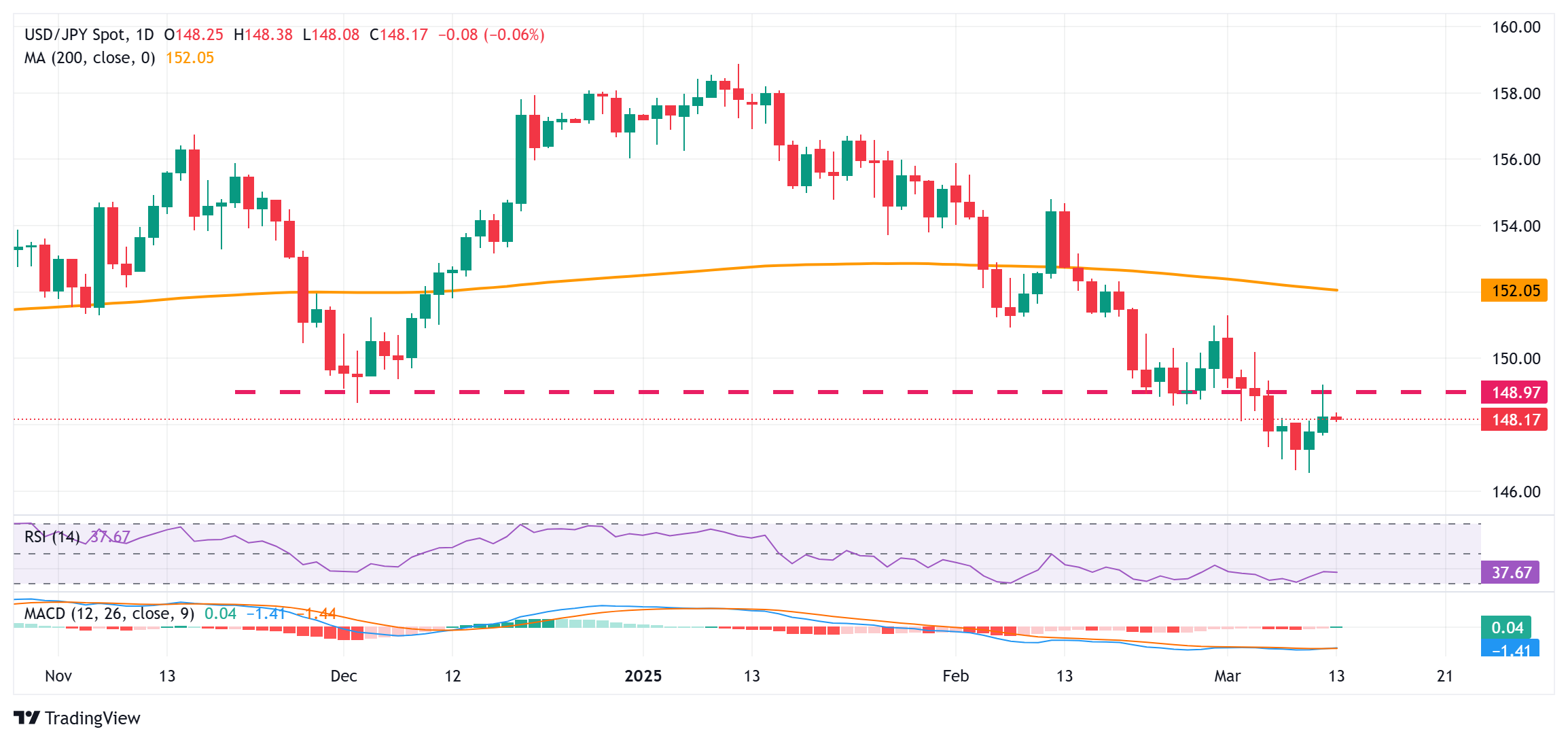- The Japanese Yen snaps a two-day losing streak against the USD and recovers further from the weekly low.
- Concerns about Trump’s trade tariffs and hawkish BoJ expectations continue to act as a tailwind for the JPY.
- Fed rate cut bets keep the USD close to a multi-month low and contribute to capping the upside for USD/JPY.
The Japanese Yen (JPY) attracts fresh buyers during the Asian session on Thursday and for now, seems to have snapped a two-day losing streak against its American counterpart. The chaotic implementation of US President Donald Trump’s tariffs and their impact on the global economy continue to drive demand for the safe-haven JPY. Adding to this, the growing acceptance that the Bank of Japan (BoJ) will continue raising interest rates amid a broadening inflation in Japan lends additional support to the JPY.
This marks a big divergence in comparison to expectations that the Federal Reserve (Fed) will cut interest rates several times this year. The resultant narrowing of the rate differential between Japan and other countries turns out to be another factor acting as a tailwind for the lower-yielding JPY. Furthermore, the underlying bearish sentiment surrounding the US Dollar (USD) drags the USD/JPY pair below the 148.00 mark. Traders now look to the US Producer Price Index (PPI) report for some impetus.
Japanese Yen draws support from rising trade tensions, BoJ rate hike bets
- US President Donald Trump’s 25% tariff on all steel and aluminum imports took effect on Wednesday. Trump also threatened that he would respond to any countermeasures announced by the European Union and Canada.
- Trump repeated his warning to reveal “reciprocal” tariffs next month on countries around the world, fueling concerns about a further escalation of a trade war and lending support to the traditionally safe-haven Japanese Yen.
- Japanese firms agreed to significant wage hikes for the third straight year to help workers cope with inflation and address labour shortages. Higher wages are expected to boost consumer spending and contribute to rising inflation.
- This potential gives the Bank of Japan more room for additional interest rate hikes this year. This, in turn, keeps the yield on the 10-year Japanese government bond close to its highest levels since the 2008 Global Financial Crisis.
- Meanwhile, BOJ Governor Kazuo Ueda signaled that they have no immediate plans to intervene in the bond market, and said that it is natural for long-term rates to move in a way that reflects the market’s outlook for the policy rate.
- Traders ramp up their bets that the Federal Reserve will have to lower interest rates this year by more than expected amid the rising possibility of an economic downturn on the back of the Trump administration’s aggressive policies.
- The expectations were reaffirmed by data released on Wednesday, which showed that the headline US Consumer Price Index (CPI) rose less than expected, by 2.8% on a yearly basis in February, down from 3% in the previous month.
- Additional details of the report revealed that the core CPI, which excludes volatile food and energy prices, eased from the 3.3% increase in January to the 3.1% YoY rate during the reported month. The reading was below the 3.2% anticipated.
- Traders now look forward to the release of the US Producer Price Index (PPI) for a fresh impetus later during the early North American session. The fundamental backdrop, however, seems tilted in favor of the USD/JPY bears.
USD/JPY seems vulnerable to slide further towards the 147.25 support zone

From a technical perspective, the overnight failure to find acceptance above the 149.00 round-figure mark and the subsequent pullback validate the negative outlook for the USD/JPY pair. Moreover, oscillators on the daily chart are holding deep in bearish territory and are still away from being in the oversold zone. This, in turn, suggests that the path of least resistance for spot prices remains to the downside. Hence, some follow-through selling below the 148.00 mark could expose the next relevant support near the 147.25-147.20 region before the pair slides further below the 147.00 mark, towards retesting the multi-month low, around the 146.55-146.50 area touched on Tuesday.
On the flip side, the 148.60-148.70 zone now seems to act as an immediate hurdle ahead of the 149.00 mark and the overnight swing high, around the 149.20 region. A sustained strength beyond the latter might prompt a short-covering rally and allow the USD/JPY pair to reclaim the 150.00 psychological mark. The momentum could extend further towards the 150.55-150.60 horizontal barrier en route to the 151.00 round figure and the monthly swing high, around the 151.30 area.
Tariffs FAQs
Tariffs are customs duties levied on certain merchandise imports or a category of products. Tariffs are designed to help local producers and manufacturers be more competitive in the market by providing a price advantage over similar goods that can be imported. Tariffs are widely used as tools of protectionism, along with trade barriers and import quotas.
Although tariffs and taxes both generate government revenue to fund public goods and services, they have several distinctions. Tariffs are prepaid at the port of entry, while taxes are paid at the time of purchase. Taxes are imposed on individual taxpayers and businesses, while tariffs are paid by importers.
There are two schools of thought among economists regarding the usage of tariffs. While some argue that tariffs are necessary to protect domestic industries and address trade imbalances, others see them as a harmful tool that could potentially drive prices higher over the long term and lead to a damaging trade war by encouraging tit-for-tat tariffs.
During the run-up to the presidential election in November 2024, Donald Trump made it clear that he intends to use tariffs to support the US economy and American producers. In 2024, Mexico, China and Canada accounted for 42% of total US imports. In this period, Mexico stood out as the top exporter with $466.6 billion, according to the US Census Bureau. Hence, Trump wants to focus on these three nations when imposing tariffs. He also plans to use the revenue generated through tariffs to lower personal income taxes.
Information on these pages contains forward-looking statements that involve risks and uncertainties. Markets and instruments profiled on this page are for informational purposes only and should not in any way come across as a recommendation to buy or sell in these assets. You should do your own thorough research before making any investment decisions. FXStreet does not in any way guarantee that this information is free from mistakes, errors, or material misstatements. It also does not guarantee that this information is of a timely nature. Investing in Open Markets involves a great deal of risk, including the loss of all or a portion of your investment, as well as emotional distress. All risks, losses and costs associated with investing, including total loss of principal, are your responsibility. The views and opinions expressed in this article are those of the authors and do not necessarily reflect the official policy or position of FXStreet nor its advertisers. The author will not be held responsible for information that is found at the end of links posted on this page.
If not otherwise explicitly mentioned in the body of the article, at the time of writing, the author has no position in any stock mentioned in this article and no business relationship with any company mentioned. The author has not received compensation for writing this article, other than from FXStreet.
FXStreet and the author do not provide personalized recommendations. The author makes no representations as to the accuracy, completeness, or suitability of this information. FXStreet and the author will not be liable for any errors, omissions or any losses, injuries or damages arising from this information and its display or use. Errors and omissions excepted.
The author and FXStreet are not registered investment advisors and nothing in this article is intended to be investment advice.



